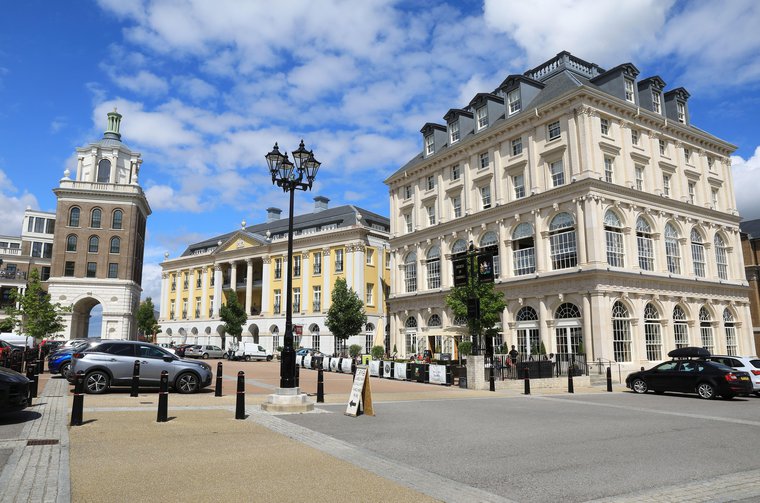Classicism is not inherently right-wing any more than Modernism is inherently progressive. It is the intent and use to which style is put that is at issue – and often this aesthetic traditionalism, sometimes seen as part of the natural order – even God-given – has links to the hard and far right. Often the design solutions proposed are informed by discredited urban thinking such as ‘broken windows theory’, linked to sometimes deadly (especially for people of colour) zero-tolerance policing in the US.
The traditionalist agenda is promoted by journalists such as The Spectator’s Douglas Murray. Like Scruton, Murray has championed a Christian Europe as a cultural stick with which to beat migrants, especially Muslims, for their differing religious values, while bemoaning a weak West’s inability to produce contemporary architecture akin to the strength of mediaeval cathedrals. Infamously, Hungary’s far-right prime minister Viktor Orbán posted a photograph of himself on Facebook holding a copy of Murray’s book ‘The Strange Death of Europe: Immigration, Identity, Islam’.
Such agendas have been linked to nationalist projects In Germany and eastern Europe to reconstruct long-vanished edifices such as the royal palaces in Berlin and Budapest, as well as anti-immigrant campaigns against mosque building in Western countries and, under Trump, an executive order demanding federal buildings be built in Classical style.
In the UK, traditionalist architecture is still rare beyond individual private houses, but Policy Exchange (PX) is at the heart of a drive to change this. It was Scruton’s work for PX that led to the Tory government’s Building Better, Building Beautiful Commission, which Scruton (who was awarded a medal by Orbán for his cultural services) chaired before his death in 2020. The commission has informed a government beauty agenda that is finding its way into national planning guidance – the ‘School of Place’ is one of its recommendations.
Right-wing ideas in the heritage sector
Policy Exchange is part of a wider right-wing network pushing its ideas into the heritage sector. Zewditu Gebreyohanes, a Policy Exchange alumna who was recently appointed to the board of the V&A Museum, runs Restore Trust, the opaquely funded group of anti-woke activists assailing the National Trust and casting Trump-like doubts on the reliability of the Trust’s recent round of online elections.
Scruton’s successor at the beauty commission, Nicholas Boys Smith – who has also worked with Policy Exchange – now heads up the government’s Office for Place, which directs national design policy. Tory proposals to give housing developers who build ‘beautifully’ a fast-track advantage have been curtailed, at least temporarily, following nimbyist blue wall by-election backlashes – but the direction of travel is clear.
A former advisor to David Cameron, Boys Smith has been made a commissioner at the heritage body Historic England and is on the advisory board of the Roger Scruton Legacy Foundation, alongside classicist architect Robert Adam. Boys Smith’s urban design agency Create Streets, which is hostile to Modernist public housing estates, also has Policy Exchange origins.
Other players in the network have links to the group of right-wing organisations based at 55 Tufton Street in Westminster. Restore Trust’s directors include Neil Record, chair of a Tufton Street think tank, the Institute of Economic Affairs. Another Tufton Street group is the New Culture Forum, which hosts speakers such as Murray.
The legacies of empire
Rather than the left, it is the right that is investing in a material cultural agenda to advance its Gramscian wars of position.
Cultural identity has been explicitly weaponised by some white supremacist groups such as Identity Europa, founded in 2016 in the US, which used imagery of Classical statues to promote a Eurocentric and purposefully exclusionary and racist cultural argument to win recruits, especially on campus. “Keep Your Diversity We Want Identity” was one flyer slogan. (It has since rebranded and makes use of Cold War Americana.)
This is also a response to the gains of Black Lives Matter and the calls to remove Confederate monuments that are a material expression of Jim Crow. No surprises, then, that this beauty myth agenda goes hand-in-hand with traditionalist opposition to changes to Britain’s commemorative landscape.
Gebreyohanes is an adviser to History Reclaimed, a pressure group focusing on supposed media distortions of the British past, especially in regard to slavery. It also opposes the repatriation from British museums of looted cultural objects. Right-wing historian Niall Ferguson is another of its adviser.
Save Our Statues, meanwhile, is a British pressure group set up by former UKIPers Peter Whittle and Richard Bingley that has been vocal since the toppling of the Edward Colston statue in Bristol. It also operates from Tufton Street and enjoys hearty backing from the likes of The Daily Telegraph.
One outcome of this resistance to reviewing the material representations of empire, is new laws proposing sentences for defacing a monument that can be longer than those for rape.
While design conservatism is itself an issue, it is the dog-whistle quality to the traditionalists’ arguments that is of chief concern. Essentially, the culture wars’ architectural front is an appeal to nativism, a stance that cultural pluralism is a zero-sum game of ‘my heritage or yours’; a dangerous fantasy that the multicultural mosaic of the post-war city can be undone.
Updated, 9 January 2023: This article was amended to remove a line stating that Justin Shubow is an adviser to History Reclaimed, which was incorrect.


Comments
We encourage anyone to comment, please consult the oD commenting guidelines if you have any questions.